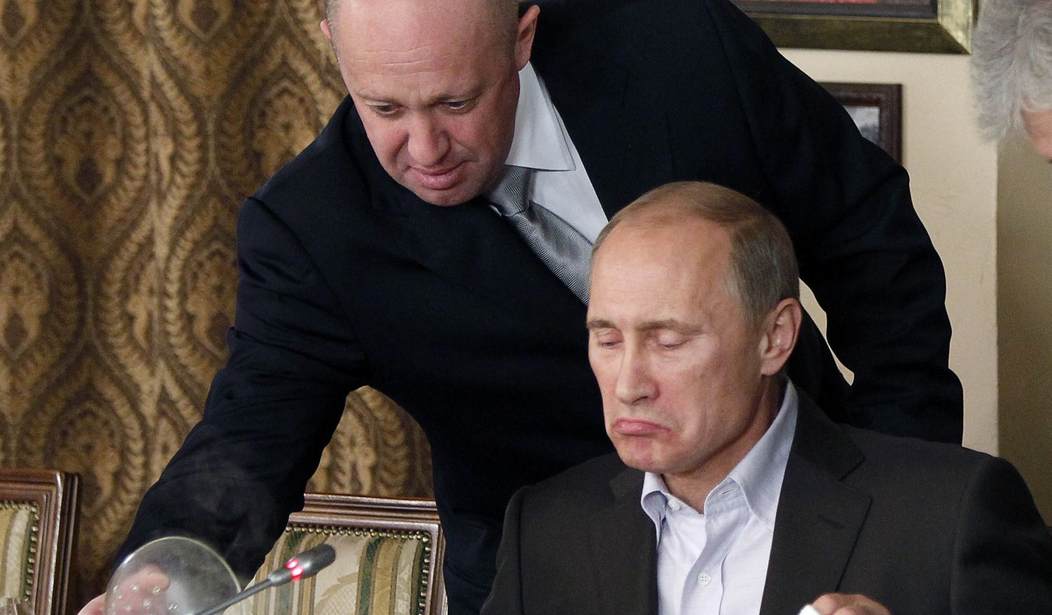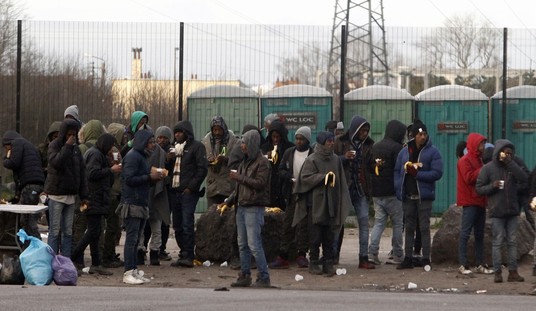First, the good news for Wagner’s prison recruits. “Zeroing” — the policy of killing anyone who complains — has been cancelled. The bad news: Ukrainians have gotten so good at “zeroing” them that Yevgeny Prigozhin’s private army can’t afford to kill their own people any more. Instead, prison volunteers get beaten, or they obey orders to act as cannon fodder in battles such as Bakhmut.
That insight comes from two POWs from a Wagner battalion, rarities indeed as most Wagner troops simply march into death. The Washington Post gained access to the two men and have a fascinating and repellent look at the life of prison enlistees, who not only have mainly gotten killed but also have apparently never been paid:
When some fighters complained, punishment was swift. One of Ilya’s friends from the Smolensk prison, a 24-year-old known by the nickname Kozan, was one of 10 fighters pulled aside after joining in a riot over conditions.
“The written contract could not be violated,” said Ilya, who said he was shown videos of Wagner officers hanging alleged defectors from balconies, breaking their hands or battering them to death. There have been numerous videos, consistent with his description, posted on social media. …
The only significant change, he said, was an apparent loosening of the kill policy that Wagner inflicted on rule breakers as the demands for soldiers continued to soar. Starting just before the New Year, those caught using drugs or alcohol had their contracts extended by several months with no additional pay. Even deserters got a reprieve, Mikhail said.
“Zeroing was canceled,” he said. “Probably because there weren’t enough people.”
According to the Post’s report, Prigozhin has also canceled prison recruitment. The POWs didn’t have any insight on this decision, but their treatment and their performance gives some hints as to why that change may have been made. The poor training added to an already undisciplined soldier makes for bad tactics, bad cohesion, and a morale problem that can and almost certainly did contagiously sweep through the ranks. Beatings and “zeroing” are either overreactions by bad leadership, a measure of the extreme nature of morale and discipline problems, or likely both.
The problem for Prigozhin is that the reputation of the Wagner group seems vastly overblown, especially when considering this report. Prigozhin had quantity but not quality, and quantity may have been enough earlier in the conflict. As the Ukrainians improved both their tactics and their materiel, the Wagner group went the other direction, especially in its recruitment. Russians still have an edge in quantity — and that matters — but slave armies perform very badly, and the Wagner group eminently qualifies for that category.
That already appears to be playing out in the new Russian offensive, according to Ukrainian officials. In the latest ISW assessment, the Russians’ four-pronged attempt to push Ukrainians back in and near the Donbas has gone largely nowhere:
Ukrainian intelligence officials continue to assess that Russia lacks the combat power and resources needed to sustain its new offensive operations in Ukraine. Representative of the Ukrainian Main Military Intelligence Directorate (GUR) Vadym Skibitsky told the AP that Russian forces intensified their offensive operations in at least four or five directions in Luhansk, Donetsk, and Zaporizhia oblasts at the beginning of February but have yet to achieve any significant successes despite continuing to exhaust their personnel and resources.[4] Skibitsky added that Russian forces are concentrating their efforts on capturing Kupyansk, Lyman, Bakhmut, Marinka, Avdiivka, and Vuhledar.
GUR Chief Kyrylo Budanov stated in an interview with Forbes that the Russian offensive is so ineffective as to be almost unnoticeable and noted that Russian forces have been rationing shells and ammunition to sustain assaults on the Bakhmut, Lyman, and Vuhledar directions while conserving shells in other areas.[5] Budanov’s statement coincides with ISW’s assessment that Russian forces are prioritizing the Bakhmut and Lyman directions and have yet to launch a significant push to advance in areas west of Donetsk City.[6] Budanov added that Russian artillery stocks decreased to 30 percent of the total number of shells. He claimed that Russia has imported a test batch of artillery shells from Iran and is currently attempting to procure another batch of 20,000 shells. Budanov previously estimated that Russian forces fired about 20,000 shells per day in late December 2022, down from 60,000 shells per day during the early stages of the war.[7] Budanov also observed that Russian tactics around Bakhmut and Vuhledar have largely shifted from artillery and mechanized attacks to infantry assaults due to the lack of shells and armored vehicles. Budanov noted that Russia had committed more than 90 percent of its 316,000 mobilized personnel to the frontlines, which further confirms Western and ISW’s assessments that Russian forces do not have significant untapped combat-ready reserves.[8] Budanov noted that the Kremlin’s stated objective of producing 800 tanks per year is unrealistic and stated that Russia can only produce 40 cruise missiles per month, which they use up in a single round of missile strikes. Russia has already lost at least 1,500 tanks and possibly as many as 2,000, as ISW has previously reported.[9]
A couple of points should grab attention in this dense excerpt. First, the fact that Russia isn’t even attempting a westward push is notable; since the loss of Kherson, they have largely been cut off from Crimea, one of the most important theaters for Russian power projection. The fact that they’re not even trying to re-establish ground lines of communication back to the peninsula indicates how Putin’s objectives have narrowed.
Second, the commitment of “more than 90% of its mobilized personnel” to the lines looks less like a well-considered offensive and more like a desperation move. Assuming this is accurate, it’s reminiscent of the Germans’ winter offensive in late 1944 through the Ardennes, hoping to break the Allied lines and force negotiations. One key difference is that the Germans actually did break through briefly, largely due to an element of surprise that Russia lacked entirely in this case. If those lines don’t move soon — like in the next few days — it’s a recipe for collapse all along the Russian lines.
That’s especially true given what these POWs tell the Washington Post about their tactics:
Ilya was one of the fighters responsible for locating Ukrainian troops. But with one drone for his entire unit and no other targeting gear, his only option was to advance under fire until he sighted the enemy with his own eyes. Most days were a slaughter, he said.
On one occasion, more than 400 of his fellow fighters were killed over 72 hours while trying to storm the village of Krasna Hora, he said, with many of the corpses left lying in the snow. Ilya said he ran past several dead men that he recognized.
Technically speaking, that’s a reconnaissance in force. In reality, it’s a turkey shoot for Ukrainian forces with superior training, tactics, and materiel. It won’t take long under those conditions for the quanity-is-quality Russian approach to get mooted, and for their lines to collapse when the Ukrainians inevitably break them and Russians have no reserves to meet those challenges.
Finally, Prigozhin has decided to fight the Ministry of Defense, which will likely mean even less integration and cohesion on the lines., It also tends to accelerate the debunking of Wagner’s mythology:
Wagner Group financier Yevgeny Prigozhin directly accused the Russian Ministry of Defense (MoD) of mistreating Wagner forces, igniting intense backlash in the information space and supporting ISW’s prior assessments of a growing Wagner-MoD fissure.[10]Prigozhin accused the MoD of lying about supplying all unconventional units with requested artillery ammunition, claiming instead that Wagner forces receive only 20 percent of the artillery ammunition promised to them.[11] Prigozhin claimed that the MoD’s statement is “spitting at the Wagner private military company (PMC)” and an attempt to hide the MoD’s “crimes against fighters” who achieve battlefield successes near Bakhmut.[12] Prigozhin published a dossier contrasting Wagner forces’ artillery ammunition usage with what the MoD distributes to Wagner forces, an image showing Wagner fighters dead supposedly from the lack of artillery support during assaults, and an interview response claiming that the support of certain regional heads, including Crimean Occupation Governor Sergey Aksyonov, has helped raise awareness of Wagner forces’ ammunition shortages.[13] Prigozhin called on the MoD to fulfill its promises rather than “deceiving” the Russian public.[14] Many prominent Russian milbloggers jumped to defend Prigozhin, spreading Prigozhin’s claims and accusing the MoD of failing to support the supposedly most effective Russian forces in Ukraine.[15] One milblogger noted that the Russian MoD is now treating Wagner forces in the same way that the MoD treats its conventional forces in Ukraine, a clear step down from Prigozhin’s prior posturing as the true victor near Bakhmut.[16] Prigozhin’s complaints also confirm that his earlier boasts of Wagner’s independence from the Russian MoD were lies.[17] Another Kremlin-affiliated milblogger criticized the rivalry between the Wagner Group and the MoD as counterproductive.[18]
This is not the profile of a successful military operation. It looks more like a war that is starting to backfire on its aggressors.








Join the conversation as a VIP Member